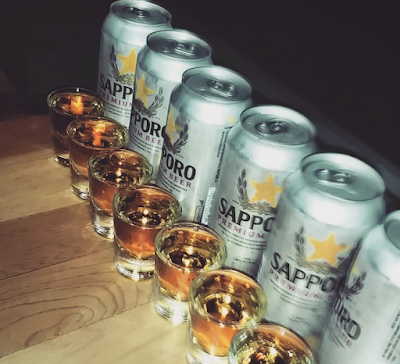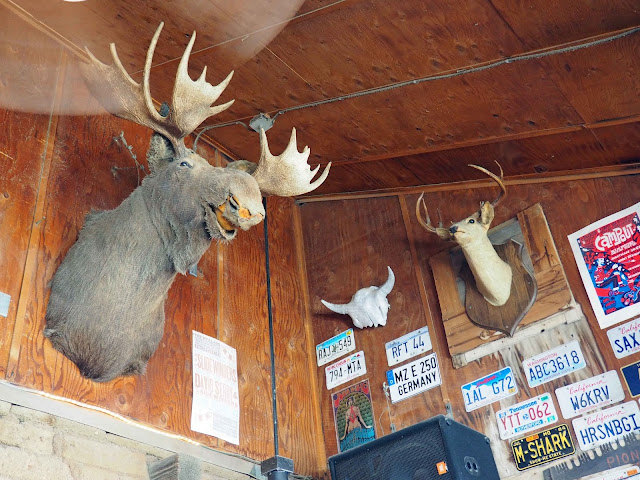It never rains: a book review I did for the Angeles Review of
Books
*
Sausage
Subversion
Los Angeles Review of
Books
The Wurst of Lucky
Peach : A Treasury of Encased Meat
author:
|
|
publisher:
|
Clarkson
Potter
|
pub
date:
|
04.05.2016
|
pp:
|
240
|
|
|
“PEOPLE WHO LOVE SAUSAGE and respect the law
should never watch either one being made.” I thought that was a quotation from
Mark Twain, and it’s possible he did say it at some time, but if so, he was
quoting either Otto von Bismarck or John Godfrey Saxe of The Daily Cleveland
Herald (there’s quite a lively online debate about origins).
In
fact, although it has a nice ring, I don’t think there’s very much wisdom in
the quote. I can’t speak for jurisprudence, but as an amateur sausage maker,
I’d happily let you see me at work, and I hardly think you’d find it
unwatchable. There’s nothing very mysterious or objectionable about the
process, and we all more or less know what’s involved. You take the tasty but
less pretty parts of an animal, grind them up, add some fat, season well, and
put the result in a length of gut. Ok, sure, I know there are non-animal and
skinless versions, but these are the outliers, and as Robert Sietsema says in
the book under review, the skinless variety “are the orphans of the sausage
world.”
But
if you’re really too sensitive a flower to be able to watch, then you probably
shouldn’t read The Wurst of Lucky Peach, or indeed any other “treasury
of encased meats,” as it styles itself. It also professes to be a “cookbook as
a scrapbook,” partly a work of reference, containing a “curated atlas we call
the Sausage Quest” — sausages of the world arranged by continent — as well as
an anthology and celebration, by multiple writers, some of whose pieces have
been reprinted from Lucky Peach magazine, although most of the
selections are new. Contributors include Rick Bayless, Jonathan Gold, René
Redzepi (of Noma), Amelia Gray, and a host of others.
They
provide some very readable essays of greater or lesser length, from a short
rant in favor of mustard and against ketchup by Peter Meehan, to an attempt by
Gideon Lewis-Kraus to explain the dubious appeal of the currywurst, “this
disgusting cut-up hotdog we inexplicably like to eat,” all the way through to
long-form examples such as Adam Leith Gollner’s account of traveling through
the back roads of rural Ontario in search of Mennonite summer sausage: “The trademark
flavor profile in the sausage comes from the bacteria, not from the spicing,”
says one Canadian sausage maker.
The book has sprightly illustrations by Tim
Lahan, and some fine moody photographs by Gabriele Stabile.
In
order to gauge accuracy, rather than to find fault, I began by looking at what
the book had to say about the British sausages I know best. I grew up in
Sheffield, Yorkshire, eating “tomato sausage” from a butcher named Funks. No
mention of tomato sausage here, nor of haslet or Oxford sausage, or a few of my
other favorites, but what’s included — on haggis, saveloys, chipolatas, toad in
the hole, and so on — is perfectly sound. It’s also pretty funny when it comes
to black pudding: “Attention UK blood sausage marketing team,” reads a typically
chatty entry in the atlas section on Europe, “You were on the right track in
swapping blood for black, but you missed the mark in designating
your national boudin noir as a ‘pudding.’”
A
fair point, and nicely put, and this kind of wit is what makes the book a
success. Nobody wants a solemn, humorless tome about sausages. There’s
something inherently subversive, irreverent, and vaguely lewd about the
subject, and those of us who already know and love Lucky Peach magazine,
are well aware that subversion, irreverence, and lewdness are part of the stock
in trade of its editors and writers, even as they remain thoroughly serious
about their enthusiasms.
The
introduction by editor Chris Ying, who is also editor-in-chief of the magazine,
encapsulates the attitude and sets the tone: "We
tried halfheartedly to limit the number of dirty jokes in this book but failed
often and with gusto. Sausage’s phallic nature never ceases to make me giggle,
and although The Wurst of Lucky Peach is rife with references to this
fact, there could have been more. Please feel free to jot down your own
additions in the margins."
Ok
then — allow me one bit of sausage humor that’s not in the book. Rob
Gronkowski, the New England Patriots tight end (no, that’s not the joke) made a
guest appearance on Top Chef, and was interviewed by Padma Lakshmi who
said, “I have a feeling you eat a lot. ”
“Yes,
I eat a lot,” Gronkowski replied. “I need a big sausage.”
“Me too,” said Lakshmi.
(It’s funny because she used to be married to Salman Rushdie.)
The
book doesn’t claim to be encyclopedic — for that you’d probably look to the
various works of Antony and Araminta Hippisley Coxe — but if you want to know
what goes into a Greek loukaniko as opposed to a Brazilian linguica, as
opposed to a longganisa from the Phillipines, The Wurst of Lucky
Peach will serve you well. You’ll also find plenty of basic information
about the more familiar boudin, boerewors, chorizo, and merguez,
and many, many kinds of hotdog.
And
comprehensive or not, I can’t imagine there’s any reader who won’t find
something new and surprising here. How many of us are familiar with the
Estonian verivorstid or the Korean sundae “often dunked in
gochujang (chili paste) to counter the metallic tang of its iron-rich filling”?
For
that matter, how many of us could actually stomach the opka hesip —
sausage and stuffed lung — a favorite of the Uyghur people in the far northwest
of China, sold by street vendors on the old Silk Road? It’s described here by
Fuchsia Dunlop, the English author and Chinese-trained chef, who writes,
“Cooked, the sausages are pleasantly piquant, the lung a strange hybrid of
savory custard and offal that appeals, surprisingly, to those who like English
puddings.” This seems more than surprising, but I’m prepared to trust her on
this one.
Elsewhere
you’ll find instructions for making your own sausages, Texas Hot Gut and duck
crépinettes among them, and there are recipes using ready-made or store bought
product: brown jambalaya, pigs in a blanket, little smokies with grape jelly
and chili sauce.
All this is fascinating and valuable stuff in itself, but in
the end it’s the quality of the writing that hooks you, and is the book’s real
attraction. These writers know their stuff and know to wear their knowledge
lightly and elegantly. You might open it because you want to know the defining
features of sheftalia, but then your eye will be caught by recipe for a
“Gatsby sandwich,” then you’ll turn to a piece by Ivan Orkin explaining why the
sausages you get in Japan seem so downright German (because of World War One
prisoners of war apparently), and then you may end up immersed in Lisa Abend’s
piece about Swedish tunnbrodsrulle, a hotdog on flatbread with instant
mashed potatoes and shrimp cocktail: “it is unspeakably
vile” she writes having sampled one example.
In
the introduction Chris Ying writes, “Our team dug deep into our libraries […]
to pull together as much accurate sausage reconnaissance as possible.” And this
book had the same effect on me. The contributors’ enthusiasm for research and
arcana is catching. I found myself searching through my own collection to see
what Apicius and Alan Davidson and The Decadent Cookbook had to say on
the subject. Plenty, let me tell you. In the last of those works the
pseudonymous authors, Medlar Lucan and Durian Gray, give a 15th-century recipe
for porpoise sausage: blood, oatmeal, and ginger are involved, and the
instruction to “let it seethe easily.”
This
in turn led me to a few fictional texts. There are, of course, references to
sausages in Great Expectations: for instance, “I was so very nervous,”
says Pip, “that I had already lighted the Aged’s sausage like a torch, and been
obliged to blow it out.” No double entendre intended there as far as I can
tell. There are sausages in Upton Sinclair’s The Jungle, too, where the
secret ingredient is rat. And there are certainly sausage rolls in Harry
Potter and the Goblet of Fire.
I
even found myself leafing through Moby Dick in hopes of finding a
mention of whale sausage, but as far as I can tell there isn’t one.
Nevertheless I was reminded of a line in that book when Melville seems to be
making a direct address to the reader and to posterity, “To write a mighty book
you must choose a mighty theme.” The sausage fits the bill perfectly.
¤
Link
to the LARB right here:
https://lareviewofbooks.org/review/sausage-subversion/












































